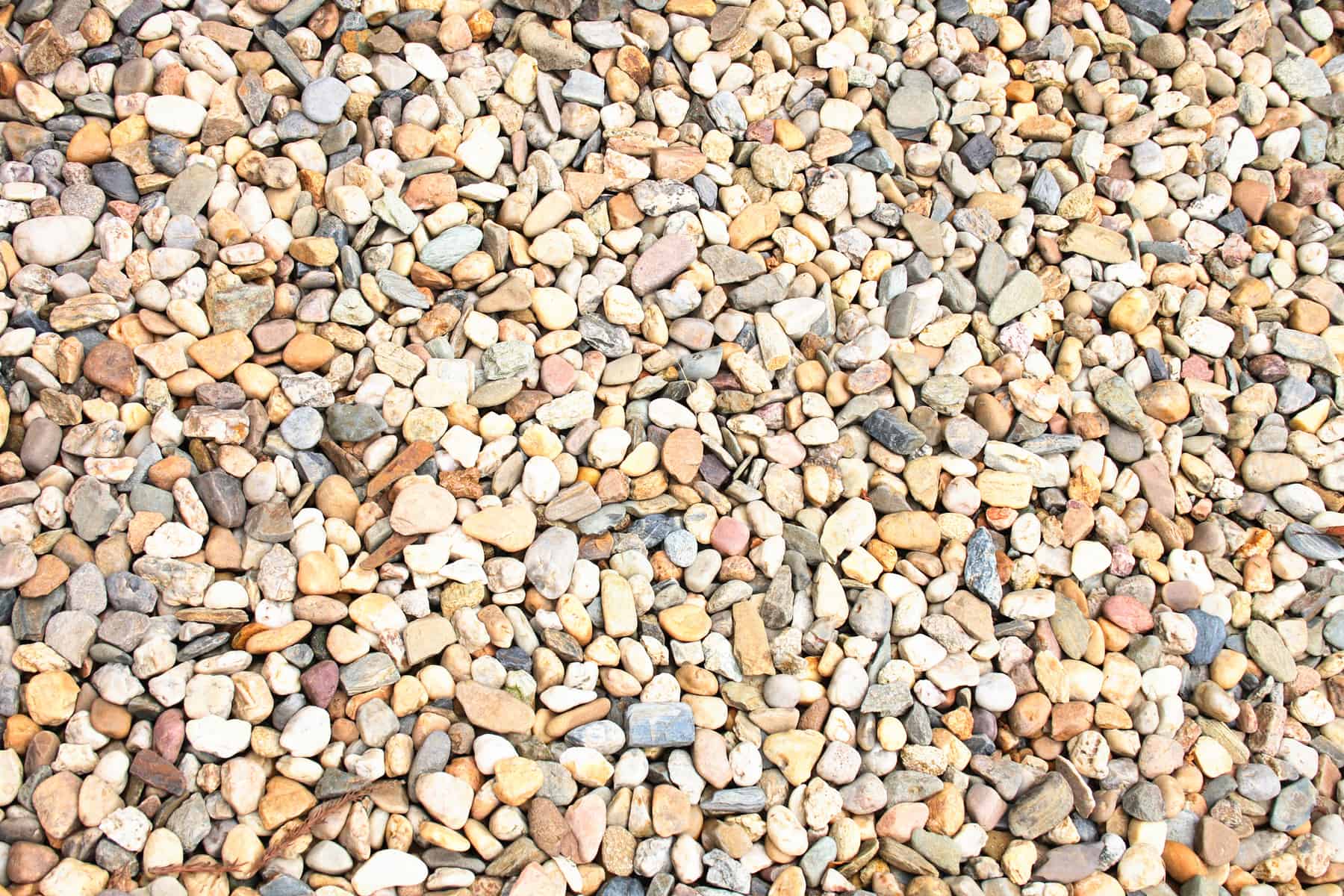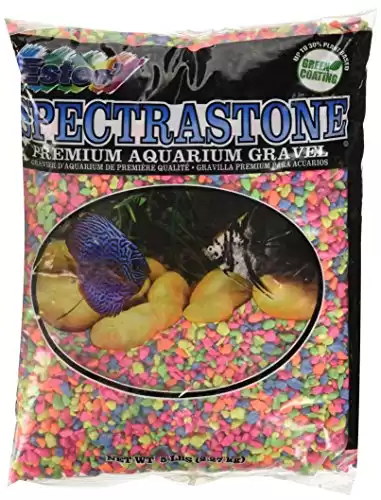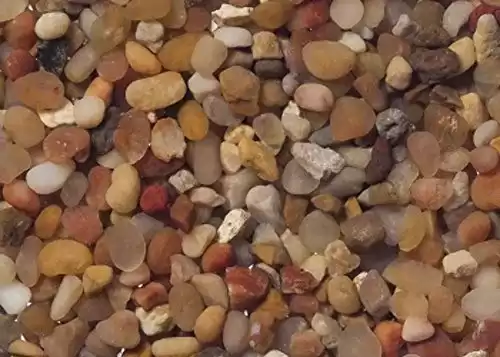The substrate that you choose for your new aquarium can really add to the general aesthetics of your setup, as well as helping to provide an environment where beneficial bacteria can grow.
If you want to keep live plants in your tank, a gravel substrate will aid healthy growth, and that, in turn, helps to oxygenate the water.
In this guide, we take a look at the different kinds of gravel substrate that are available for use in the fish tank, as well as giving you some tips on how much gravel to use and how to keep it clean.
Why choose gravel?
Gravel is the most popular choice of substrate for home aquariums.
You can buy aquarium gravel in different sizes and colors, making it an extremely versatile choice of substrate, and its price is very affordable. Most aquarists prefer to use smooth gravel of small diameter so that it doesn’t injure vulnerable fish, while still providing a secure anchor point for living plants.
If your tank is home to a betta fish, fantail goldfish, or another species that has delicate, floating finnage, make sure that the gravel you choose does not contain sharp, flinty fragments that could tear your pets’ vulnerable caudal fins.
Bottom-dwelling species, including catfish, have sensitive whiskers or barbels, which they use to rummage through the gravel in search of morsels of food and other detritus. Gravel that is too large or sharp can damage or even tear off the delicate barbels, leaving the fish susceptible to bacterial infection.
Planted tanks
Gravel is a much better choice of substrate for planted tanks than sand, as it provides plant roots with a suitable medium in which they can root securely. Some large plant species have very complex root systems that need plenty of space to spread, and that means you’ll need a deeper layer of gravel.
The growth rate, overall health, and color of your plants will be dependent on the quality and quantity of nutrients in the tank. So, when you’re creating a planted tank, you must be sure to include a nutrient layer underneath the gravel.
Spread a 1-inch layer of nutrient medium on the tank bottom, and add a couple of inches of gravel on top of that. If your tank is larger than 55 gallons, increase the layer of gravel to 3 inches in depth.
How much gravel should you use?
Some types of gravel are more expensive than others, so it’s essential that you know exactly how much you need to buy.
The depth of the gravel for aquariums depends on a few factors, including:
- The dimensions of your tank
- The fish species that are living in the aquarium
- Whether you have live plants in your setup
- Whether you have a canister or an undergravel filter
As a general rule of thumb, tanks up to 55 gallons generally need 1.5 to 2 inches of gravel substrate, whereas anything larger than that requires 3 to 4 inches’ depth of substrate.
If you have an undergravel filtration system, you’ll need to add a little more substrate. For optimal efficiency, undergravel filters need coarse, slightly larger gravel pieces that allow waste to fall through onto the filter screen. If the gravel is too fine, the filter screen may become clogged.

Aquarium gravel calculators
A search on the internet will find many useful substrate calculators that you can use to work out how much gravel you need to buy.
Alternatively, you can use a quick manual calculation to work out how much gravel to buy. The calculation is super-simple, and you don’t need to be a math genius to do it!
Here’s an example:
- Start by measuring the width and length of your aquarium, e.g., 20″ x 40.”
- Now, multiply those figures together, e.g., 20 x 40 = 80
That figure equals the weight of gravel in pounds that you need to create 1.5 to 2 inches of substrate. Many manufacturers sell their gravel in kilograms. To convert pounds to kilograms, simply divide your total in pounds by 2.2. So, in the case of our example, you would divide 80 by 2.2, which equals 36.3 kilograms.
So, you know that you need at least 36.3 kilograms of gravel to provide you with a layer of a substrate a couple of inches deep in a 20″ x 40″ aquarium.
Different types of aquarium gravel
Before we take a look at the various types of gravel that you can buy, we must stress that you must NEVER harvest gravel from the natural environment and use it in your aquarium.
Anything that you introduce to your tank has the potential to bring with it bacteria, parasites, and other nasties that you certainly don’t want in your aquarium.
So, the best place to find new aquarium gravel is at your local fish store, where they will have plenty of choices for you to consider at a reasonable price.
Colored gravel
Some people like to use colored gravel in their tanks, and it has a particular appeal to kids. However, the majority of the colored gravel options that you see are made from a naturally occurring mineral called white dolomite.
White dolomite is packed with magnesium and calcium. Now, that may work well if you have a Rift Lake cichlid tank where the fish prefer alkaline conditions and a high pH level. However, if your fish need neutral or soft water, you’ll need to add a pH buffer to correct the water chemistry if you use colored gravel.
Also, colored gravel tends to sell for a higher price than plain, natural-looking gravel.
Inert gravel
Inert gravel is called that because it doesn’t contain any substances that will alter the water chemistry of the tank. That’s crucial if you intend to keep fish that need neutral or soft water, such as Discus.
Pea gravel
Pea gravel is probably the most popular choice of a substrate with hobbyists, especially if you want a natural look for your aquarium.
This type of gravel is formed from small fragments of assorted types of stone. The stone that is used to make pea gravel is more or less inert, so the water chemistry in your tank won’t be affected or destabilized.
Pea gravel is perfect for a planted tank, and it also works well with undergravel filters. However, using pea gravel as a substrate does have a few drawbacks.
First of all, pea gravel can contain sharp or rough pieces that may cause issues for catfish and long-finned species. Also, most pea gravel contains lots of dust and sand, meaning that it takes a lot of rinsing before you can introduce the gravel to your new aquarium.
Why use gravel?
Gravel has many advantages for the aquarium hobbyist, including:
Water flow
Gravel allows water to flow more freely through it than other substrate choices, such as sand.
That’s ideal if you have an undergravel filter system. Also, free-flowing water can help to prevent air pockets from forming, where harmful bacteria can accumulate and potentially pollute the water or cause outbreaks of disease in the tank.
Filters
Unlike sand that can cloud the water and get sucked into mechanical filtration systems when it’s disturbed by burrowing fish, heavier gravel stays put on the bottom of the tank.
Crystal clear water
Unlike sand, gravel doesn’t fly up and create clouds in the water, which can be a problem f you have fish species in your collection that enjoy digging or burrowing in the substrate.
Versatile
Gravel is available in a very wide range of colors ranging from pure white, through rainbow, pastel shades, to jet black.
That allows you to customize your aquarium’s look to complement the interior décor scheme.
Beneficial bacteria
Each piece of gravel provides a surface area where beneficial bacteria can potentially grow. When you consider how many pieces of gravel it takes to cover the floor of your aquarium, that’s a lot of surface area for those “good” bacteria!
Algae
Aquarium owners have a love-hate relationship with green algae.
Extensive growth of algae undoubtedly looks unsightly on your tank glass and ornaments, but many fish species need and enjoy algae as a part of their diet.
Gravel can encourage algal growth, so it’s worth considering adding a few algae-eaters to your setup to help keep it under control. Also, you can clean the algae off your glass and other surfaces without depriving your fish of a valuable food source.
Best for plants
Gravel is the best choice of substrate for planted tanks, as it provides a firm anchor point for roots. Also, fish waste will work its way into the gravel, where it provides a natural source of fertilizer for your plants.
Disadvantages of gravel
Despite its many plus points, aquarium gravel does have a few drawbacks.
Time-consuming to clean
Gravel allows fragments of uneaten food, fish waste, and general detritus to fall through between the cracks, where it can collect and decompose. Eventually, that causes the water quality in the tank to deteriorate and places a burden on your filtration system.
Wasted food
Some fish species need live and frozen foods to form the main part of their diet.
Live foods, such as bloodworms and brine shrimp, can easily sneak down among the gravel fragments, where they die and rot. That not only pollutes the environment and wastes expensive foods, but it also means that your fish may go hungry.
Danger to fish
If you buy poor quality aquarium gravel, fish with trailing finnage and those that like to burrow into the substrate could be injured by rough or sharp fragments of gravel.
Also, if you have decorative snails in your aquarium, they won’t enjoy moving over rough, sharp gravel.
Dust
The main issue that most hobbyists have with all kinds of gravel is that it tends to be very dusty. Even the gravel in aquarium shops that you see advertised as “pre-washed” is invariably smothered in fine, sandy dust.
So, before you can add the substrate to your tank, you’ll need to rinse it through running water over and over again until the water runs clear. If you have five or six bags of gravel to prepare, that can take a long time!

How to maintain aquarium gravel
Even gravel substrate that’s advertised as pre-washed needs thoroughly rinsing before you can add it to your tank. Pea gravel is especially bad for containing large amounts of dust, and fine, sandy particles that will cloud your water and clog your filters if it’s not rinsed away before you add it to your new tank.
In established aquariums, you’ll need to remove any fish waste and general detritus that’s worked its way down into the gravel. The best way to tackle that task is by using an aquarium vacuum or siphon cleaner. As the vacuum siphons away dirt, it also removes water, so you can incorporate your gravel cleaning task into your general weekly tank maintenance regimen.
Final thoughts
Gravel for aquarium substrate is a very popular choice that you’ll see in many freshwater tanks.
Gravels for aquarium use can be found in many different colors, allowing you to choose the perfect look for your home tank. If you have a planted tank, gravel can help to anchor plants, as well as to trap small amounts of fish waste that provides a source of nutrition for the plants.
On the downside, gravel substrate does add to the maintenance requirements of your fish tank, but we think that, overall, gravel’s advantages do outweigh the few disadvantages that it has.




